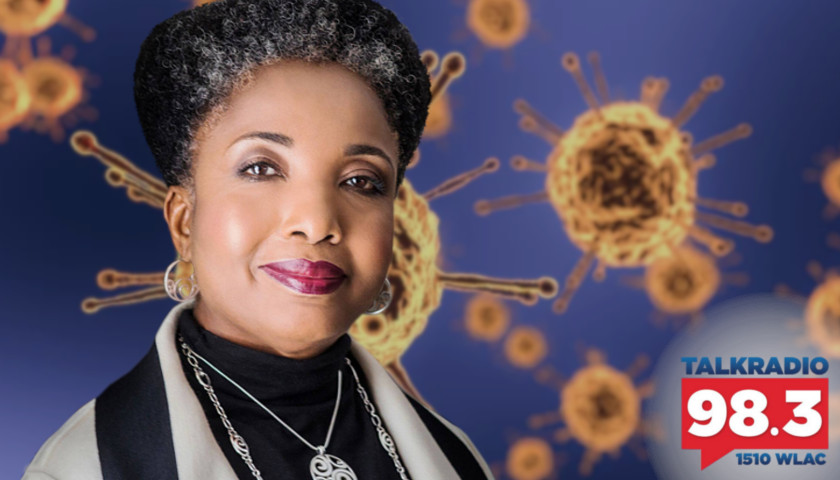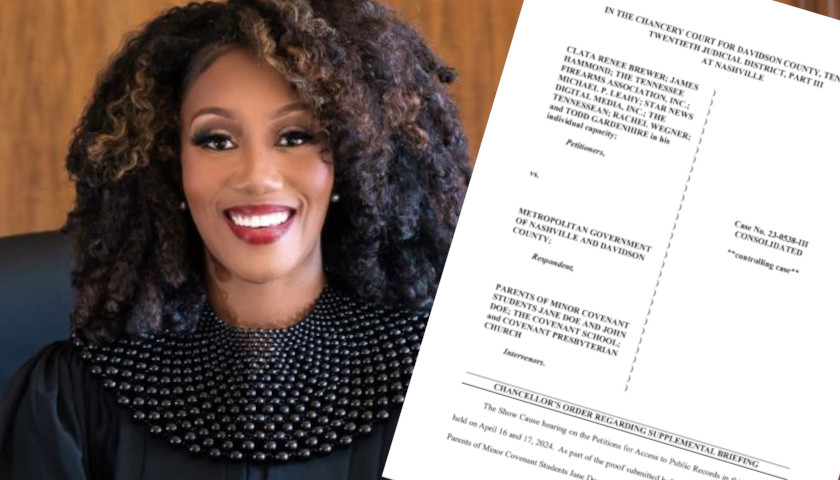Live from Music Row Thursday morning on The Tennessee Star Report with Michael Patrick Leahy – broadcast on Nashville’s Talk Radio 98.3 and 1510 WLAC weekdays from 5:00 a.m. to 8:00 a.m. – Leahy was joined on the newsmakers line by all-star panelist Dr. Carol Swain.
During the second hour, Swain discussed her recent commentary piece at The Tennessee Star and expressed her concern now is that they are political and financial incentives to inflate the numbers. She questioned the models used to track the coronavirus and explained how those models can be manipulated to produce desired numbers.
Leahy: But Carol today is sitting at home and sheltering safely. We are doing this over the phone. Carol, how are you doing this morning? Carol are we there?
Swain: My AirPod failed me for a second.
Leahy: That’s OK. We are all dealing with the new reality of the coronavirus social distancing restrictions. Its much more fun having you here in the studio. You make jokes. You laugh. You make me laugh. Its fun having you in here. Over the phone, it’s a little different?
Swain: I keep my routine. I get dressed for the day. I pretend that I’m going to the studio to meet you. You and I have had an interesting dialogue about the coronavirus over the past several weeks. Yet we had a fascinating commentary on the coronavirus and politics.
Leahy: Let me get to the conclusion and you can fill us in at how you arrived at this. I’m going to read from your piece at the tennesseestar.com. You wrote, “I’m concerned about the politicization and the efforts of the left to wreck the economy. Years from now the American people will look back at this period with regret and media manipulation and gamesmanship that placed us in a reactive mode.
What is different about this disease is the non-stop media coverage. We have not had this with previous pandemics. What we are watching and living through includes raw politics and the desire of Democrats to win the November elections by any means necessary.”
As Chicago’s Rahm Emanuel famously said, “You never let a serious crisis go to waste.” So, Carol, that is your conclusion. Tell us how you arrived at that conclusion.
Swain: I have been thinking about the statistics surrounding the coronavirus. The number of deaths relative to the population of the world. The population of the USA. And looking at other pandemics it was never handled that way. And so that was part of what I had been focusing on over the last few weeks. And then the problems with statistical modelings.
Leahy: Oh yes.
Swain: My background is a political science and I know how easy it is for scientists to manipulate numbers either deliberately or the models are inaccurate because of the assumption. A lot of times the assumptions in every case whatever you put in the model determines the results you get.
Leahy: Yeah. Tell us about when you look at these models. Do you have any particular model in mind? The one that is most often cited now in the past week is this Institute for Health Metrics and Evaluation model coming out of the University of Washington and funded by the Bill and Melinda Gates Foundation. That’s the one that says 93,000 million deaths expected by the coronavirus by August 4. Is that the one you look at the most? Or are you just talking about in general?
Swain: Well first of all people need to read the article because I document what I’m talking about. The models we base our positions on predicted that millions of people dying. And those numbers were generated by looking at the people who came in sick and tested positive for the coronavirus.
And that’s problematic because if you were doing a random sample of testing of the whole population the results would be dramatically different than when you focus just on sick people. And normally social researchers would not have something like that. They would have a random sample of the population. So from the very beginning, the numbers were exaggerated just because you were only looking at sick people.
Leahy: Good point, however, let me just say this if we are today there are now as of midnight this morning 5,100 deaths in the United States due to COVID-19. That’s a fact that’s been widely reported by 50 State Departments of Health around the country and the District of Columbia.
To me, it does not stretch credulity to look at this IHME model which predicts 93,000 deaths by August 4. If you look at how these things spread, it seems to me that that aggregate number would be consistent with 93,000 deaths by August 4. What do you think of that?
Swain: First of all I think people need to read my article but my concerns now are that normally for cardiovascular disease, 647,000 died last year of that disease. The CDC ranks the various causes of death. My concern now is that they are political and financial incentives to inflate the numbers.
I believe as evidence of people who were dying anyway of cancer and various diseases that they’re labeling those as coronavirus diseases. And so I’m denying that the disease isn’t serious. It’s highly contagious. We need to take all the precautions. But we take precautions for the same reason that we take precautions to avoid the flu. None of us want to have heart disease or cancer or any number of other diseases.
And so any way you look at it in the past those kinds of numbers in a country of 327 million people. We would not be making the kinds of decisions we’ve made based on those numbers. And even if you look at New York City they have 8.6 million people in that city and the number of deaths in New York I believe last night was like 1,100?
Leahy: I think it’s up significantly from that. I think it’s over 2,000 actually in the state.
Swain: New York State.
Leahy: You might be right about New York City itself. Yeah, I got you.
Swain: 19.5 million people in the whole state.
Leahy: Right.
Swain: And so out of that let’s say 3,000 had died and that’s a lot of people. They make up the bulk of the deaths in the United States. And I have people asking me on Twitter saying why do I think New York has so many deaths?
And I could give a spiritual answer to that as well as many other people. And my first article the one we talked about last week talked about how a year ago, pretty much at this time we were above in this nation about New York’s governor signing the least restrictive abortion law in the land that allowed the abortion until the moment of birth.
And today I learned something that I did not know. Or I had forgotten. In 2015 the Empire State Building in New York lit up and projected the image of Kali the Hindu Goddess of death. They celebrated Kali the Hindu Goddess of death in 2015. As a Christian the fact that that city honored the Hindu goddess of death to me. They have celebrated death.
Leahy: There will be a divergence of opinion here. I would not attribute the problem in New York City to a spiritual problem as you suggest. I would say if you look at it there are two reasons that stand out. First, they ignored social distancing warnings early on and they invited everybody to come down in Chinatown in February. A half a million people celebrating the Lunar New Year. Secondly, they have the highest population density in the United States I think like 67,000 per square mile. And I think that maybe one of the big reasons for that.
Swain: That’s a secular response. I’m giving you a spiritual response and even that is a reflection of how they feel that they are in charge. That they have no consequences for what they do.
Listen to the second hour here:
– – –
Tune in weekdays from 5:00 – 8:00 a.m. to The Tennessee Star Report with Michael Patrick Leahy on Talk Radio 98.3 FM WLAC 1510. Listen online at iHeart Radio.









Thank you Carol Swain for insight. Always appreciate your strong voice.